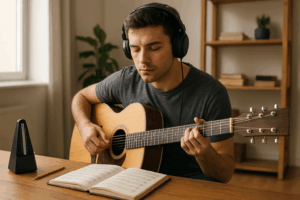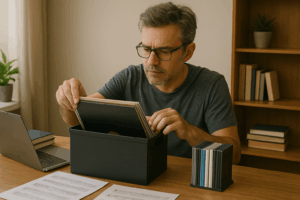In music, silence can be just as powerful as sound. Pauses and rests not only give listeners a chance to absorb what they’ve heard, but they also create anticipation, tension, and emotional depth. While music is often associated with constant sound, the spaces between the notes are crucial for shaping a compelling performance or composition. In this article, we’ll explore how to use silence and pauses effectively to enhance your music and create a more dynamic and expressive sound.
1. Understand the Power of Silence
Silence in music isn’t simply about the absence of sound; it is a musical element in itself. A well-placed pause can change the emotional landscape of a piece, emphasize a musical phrase, and provide space for the listener to process the music. Silence can also create contrast, making the following notes or phrases more impactful.
How Silence Works in Music:
- Creates Tension: A well-timed pause before a resolution creates tension and heightens the emotional payoff when the music resumes. For example, in a dramatic moment, stopping before the climax gives the listener a sense of anticipation.
- Allows Reflection: Silence allows the audience to reflect on what they’ve heard. It gives them time to absorb the emotion of a melody or phrase before moving to the next section.
- Increases Impact: Silence, when used strategically, can make the music that follows it feel more powerful. This is especially effective in dynamic shifts—after a quiet section, a sudden burst of sound becomes more striking.
By recognizing silence as an active component of music, you can use it intentionally to deepen the emotional impact of your composition.
2. Use Pauses for Dramatic Effect
Pauses can be used to highlight important moments in your composition or performance. Whether it’s between phrases, at the end of a section, or before a key change, a pause can draw attention to a particular moment and make it stand out.
How to Use Pauses Effectively:
- Between Phrases: Pauses between musical phrases allow the listener to “digest” the music. It separates ideas, allowing the transition to feel more impactful. For example, after a musical question (a phrase that asks for resolution), a pause can emphasize the response that follows.
- Before Key Changes or Climaxes: Placing a pause right before a key change or musical climax builds anticipation. The silence heightens the tension, making the return of sound even more dramatic.
- At the End of a Piece: A well-placed pause at the end of a piece or section gives the audience a moment to reflect on the music and absorb its emotional weight. The silence before the final resolution can make the conclusion feel more profound.
Strategically placing pauses can bring depth and drama to your composition, capturing the listener’s attention and creating a lasting impression.
3. Play with the Rhythm and Timing of Pauses
Pauses are not always of equal length; the timing and duration of silence can greatly affect the flow and feel of the music. Experimenting with the rhythm and timing of pauses can lead to unique, unexpected results that keep the listener engaged.
How to Experiment with Timing and Rhythm:
- Use Shorter Pauses for Tension: A quick, short pause (like a quarter-note rest) can heighten the sense of urgency and tension, while longer pauses can allow the listener to reflect and anticipate.
- Vary the Length of Pauses: Don’t feel constrained by traditional rhythms when incorporating silence. You can experiment with irregular pauses or rests that go beyond the typical pattern. This will create more interesting dynamics and can add surprise to your piece.
- Syncopated Pauses: Just as you can use syncopation in rhythm to surprise the listener, you can also use pauses in syncopated places—between offbeats or unexpected moments in the measure—to create rhythmic tension.
Varying the timing and length of pauses will keep your audience on their toes, making the music more engaging and unpredictable.
4. Silence in Improvisation
In improvisation, silence is a tool that allows you to shape the flow of the music and add dynamic contrast. By intentionally leaving space in your improvisation, you can create dramatic pauses that build tension and allow the music to breathe.
How to Use Silence in Improvisation:
- Pause Between Ideas: During an improvised solo, allow space between your musical ideas. After playing a phrase, leave a moment of silence before continuing. This allows the audience to catch up with your ideas and enhances the impact of the next phrase.
- Use Silence to Emphasize Phrasing: Pauses can help emphasize a specific phrase or idea in your improvisation. For example, you might pause right after an especially striking or dramatic note, letting the silence carry the emotional weight.
- Incorporate Breathing Space: As you improvise, allow yourself to breathe and take time between phrases. These moments of silence will make your performance feel more expressive and will help your ideas resonate.
In improvisation, silence allows you to control the flow of your music, giving you room to express emotion and build tension.
5. Silence in Ensemble and Orchestral Music
In ensemble and orchestral music, silence plays a crucial role in ensemble cohesion and communication. The spaces between instruments can create balance and clarity, allowing each part to shine while still contributing to the overall harmony.
How to Use Silence in Ensemble Music:
- Allow Each Instrument to Shine: In a group setting, pauses and rests can be used to highlight individual musicians or sections. A soloist or a smaller group can be given space to stand out, while the rest of the ensemble remains silent or provides light accompaniment.
- Use Silence for Timing Precision: In orchestral music, silence is important for ensuring timing and synchronization. Pauses before key changes or entrances help maintain precision and clarity, ensuring that all players come in at the right moment.
- Create Contrast Between Sections: Pauses can create a powerful contrast between different sections of the ensemble. For example, after a loud, energetic section, a moment of silence can make the next section feel more delicate and introspective.
In ensemble settings, silence not only helps with timing but also serves as a tool for musical communication, allowing the group to respond to each other in real time.
6. Experiment with Silence in Your Own Compositions
Don’t be afraid to experiment with silence in your compositions. Composers often use silence in creative ways to express emotion, build tension, and add complexity to their pieces. It’s an invaluable tool in any composer’s toolkit.
How to Experiment with Silence in Your Compositions:
- Use Silence to Create Space: Don’t feel obligated to fill every moment with sound. Leaving room for silence can make the music feel more open and allow your ideas to breathe.
- Pair Silence with Contrast: Pair moments of silence with sudden changes in dynamics or texture to create contrast and surprise. This can lead to more dramatic shifts in mood and intensity.
- Reflect the Emotion of the Piece: In a slow, contemplative piece, silence can represent a moment of reflection or introspection. In an energetic, fast-paced piece, pauses can create urgency and anticipation.
By experimenting with silence, you can create a unique sound and enhance the emotional depth of your music.




